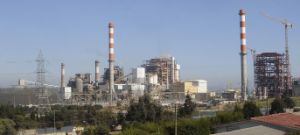
An increase in solar and wind power generation is forcing a sharp drop in the contribution of these units, especially in the Sing, they say.
Industry warns of obstacles to operate thermal power plants
The growing participation of renewable generation plants -mainly wind and solar- in the national electricity system is not only having positive effects. There is growing concern in the industry about the future of the thermal power plants, both coal and natural gas, which in some areas of the country are producing less and less energy and are even relying almost exclusively on supporting the contribution of non-conventional renewable energies (NCRE), despite the large investment made in the construction of these plants.
In this regard, there has been growing concern in the sector about cycling – constant turning on and off of thermal units to cover periods when NCRE is not contributing – to which this park is being exposed, especially in areas such as the Norte Grande Interconnected System (Sing) and in the north of the Central Interconnected System (SIC), which is where NCRE has the largest share. This phenomenon not only causes technical problems by accelerating the end of the turbines’ useful life, but also reduces the income generated by the plants by lowering their share of electricity production.
This is a situation that has already occurred in other markets and has been resolved mostly through regulatory changes.
“Today, electricity systems worldwide are undergoing profound changes in the traditional way in which they are operated, due to the growing penetration of NCRE. In Chile there have been various incentives to promote these sources, such as the laws that set renewable quotas at 10% and then 20%, and more recently the definition of hourly blocks from the electricity bidding process,” says a report by the consulting firm Systep, headed by academic Hugh Rudnick.
The report warns that the high variability of NCRE implies a greater requirement for on/off cycles during the nights and shutdowns during the day (cycling), which could translate into higher variable costs for these plants.
Although natural gas plants are generally considered to have the greatest flexibility to support NCRE plants, given their fast start-up and shutdown times, the phenomenon is also being observed today in coal-fired plants, which have a different nature and where the activation process takes several hours. This accelerates the deterioration of the turbines much more than gas-fired units. This is due to the fact that the operation of the Chilean market favors the most economical sources, so NCRE -which have lower costs- are the first to be dispatched.
Letter from Engie Energía
The situation was brought to the attention of the Sing electricity market operator, CDEC-Sing, by Engie Energía Chile. In a letter sent by the French-owned power company on October 7, it expressed “growing concern about the cycling of its U12 and U13 coal units between August and October of this year”. Something similar occurred between April and May at the GasAtacama units, which are operated by Endesa Chile.
As explained by the French electricity company, the massive entry of wind and solar power plants “has led to existing generation units having to reduce or even stop their generation during these hours, and then strongly increase their generation during the rest of the hours in order to complement power generation”.
They added that “in our letter to CDEC we informed our concern about the increase in the number of departures and stoppages of two of our coal units (…) they are units that were designed for base load operation and have operated that way for the 33 years they have been in service”. According to their calculations, “an increase in their number of items increases the risk of their continued operation, raises their maintenance costs, decreases their reliability and reduces the useful life of the machines”.
Regulatory changes
The Systep report warns that “in addition to reservoir power plants, thermal power plants are also expected to compensate for the variability of NCRE injections by increasing/decreasing their generation, or even switching on and off several times (cycling).
This results in a decrease in their energy revenues and an increase in the maintenance of these technologies, increasing their costs”, and assures that, in an extreme scenario, “it could lead to the situation that these thermoelectric plants do not recover their fixed costs”.



